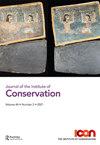Rediscovering Ancient Egypt: consideration of the legacy, ethics and aesthetics of previously restored Egyptian artefacts
IF 0.5
0 HUMANITIES, MULTIDISCIPLINARY
引用次数: 1
Abstract
Abstract National Museums Scotland’s (NMS) new permanent Ancient Egypt gallery project at the National Museum of Scotland in Edinburgh gave an opportunity for current conservators and curators to collaboratively assess and evaluate historic conservation and restoration treatments. Restoration had been an integral element in transforming archaeological fragments from Egypt into museum display objects in the UK, and restoration often went beyond the purposes of stabilisation and preservation to the point of obscuring or distorting original features. The evaluation of these earlier restorations informed treatment decisions and became one of the major challenges for conservators. Common overarching questions were applied in deciding the appropriate approach balanced against the principles of minimum intervention set out in NMS’s conservation policy and the time and resource limitations of a capital project. The process provided an important opportunity to review the collections’ history and to reassess the museum’s conservation and curatorial aims and values. This article examines some of the issues and challenges with dealing with previously restored ancient Egyptian collections through selected case studies from the project, involving gilded coffins, stone statuary, and smaller inlaid wood and faience items.重新发现古埃及:对先前修复的埃及文物的遗产、伦理和美学的思考
摘要苏格兰国家博物馆(NMS)位于爱丁堡的苏格兰国家博物馆的新的永久古埃及画廊项目为现任保护人和策展人提供了一个合作评估和评估历史保护和修复处理的机会。在英国,修复是将埃及的考古碎片转变为博物馆展示品的一个组成部分,修复往往超出了稳定和保护的目的,甚至模糊或扭曲了原始特征。对这些早期修复的评估为治疗决策提供了信息,并成为保育员面临的主要挑战之一。在决定与NMS保护政策中规定的最小干预原则以及资本项目的时间和资源限制相平衡的适当方法时,应用了共同的总体问题。这一过程提供了一个重要的机会来回顾藏品的历史,并重新评估博物馆的保护和策展目标和价值观。本文通过该项目中选定的案例研究,探讨了处理先前修复的古埃及藏品的一些问题和挑战,包括镀金棺材、石像以及较小的镶嵌木材和陶器。
本文章由计算机程序翻译,如有差异,请以英文原文为准。
求助全文
约1分钟内获得全文
求助全文
来源期刊

Journal of the Institute of Conservation
HUMANITIES, MULTIDISCIPLINARY-
CiteScore
1.50
自引率
0.00%
发文量
22
期刊介绍:
The Journal of the Institute of Conservation is the peer reviewed publication of the Institute of Conservation (Icon). As such, its aims reflect those of Icon, to advance knowledge and education in conservation and achieve the long term preservation and conservation of moveable and immoveable cultural heritage. The Journal provides a collective identity for conservators; it promotes and supports both the profession and professionalism. With international contributions on all aspects of conservation, it is an invaluable resource for the heritage sector. The specific aims of the Journal are to: 1. promote research, knowledge and understanding of cultural heritage conservation through its history, practice and theory 2. provide an international forum to enable and disseminate advances in research, knowledge and understanding relating to conservation and heritage 3. champion and support professional standards of heritage conservation in the UK and internationally 4. provide a permanent record of issues relating to conservation and heritage 5. be financially and operationally sustainable. To achieve these aims, the Journal invites contributions from all those involved in the conservation of cultural heritage and related activities. Areas of interest include understanding cultural heritage materials and their degradation; subject reviews and histories of cultural heritage materials and conservation treatments; new, innovative or improved approaches to conservation and collections care theory, practice, communication, management and training; case studies demonstrating new, innovative or improved approaches; and conservation in its wider context. Submitters are encouraged to demonstrate how their work is of practical application to conservation. To maintain professional standards and promote academic rigour, submissions of articles and shorter notices are subject to an anonymous peer review process.
 求助内容:
求助内容: 应助结果提醒方式:
应助结果提醒方式:


